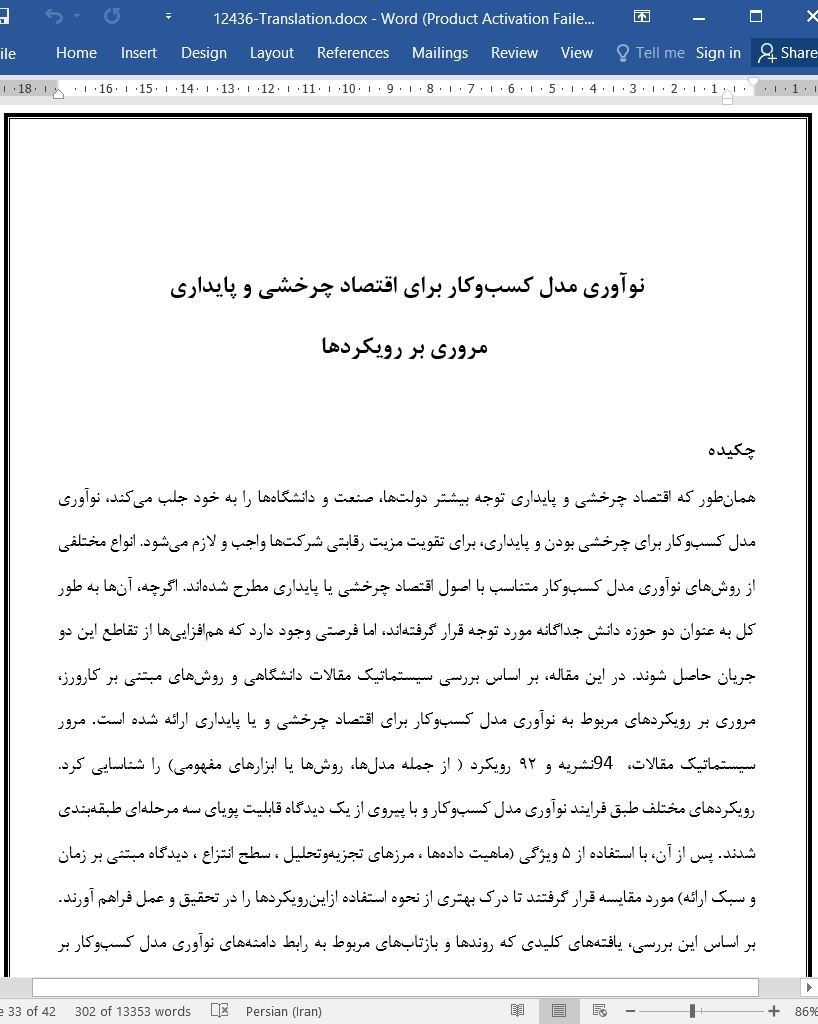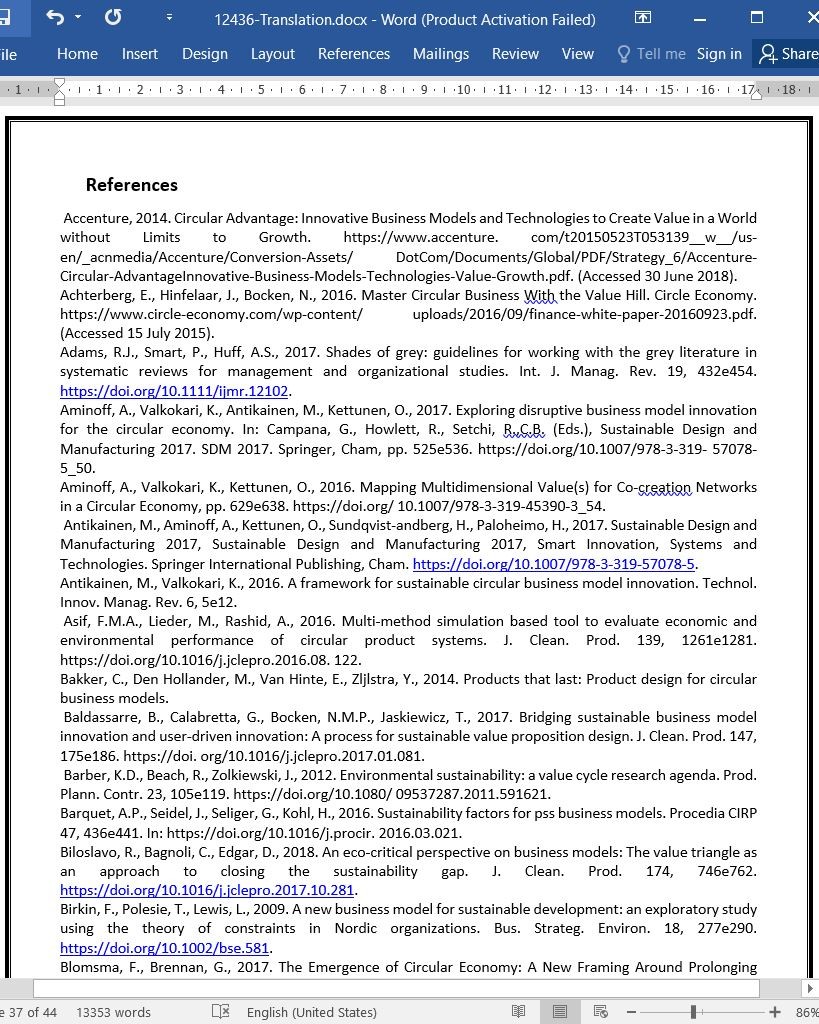
دانلود مقاله نوآوری مدل کسب و کار برای اقتصاد چرخشی و پایداری
چکیده
همانطور که اقتصاد چرخشی و پایداری توجه بیشتر دولتها، صنعت و دانشگاهها را به خود جلب میکند، نوآوری مدل کسبوکار برای چرخشی بودن و پایداری، برای تقویت مزیت رقابتی شرکتها واجب و لازم میشود. انواع مختلفی از روشهای نوآوری مدل کسبوکار متناسب با اصول اقتصاد چرخشی یا پایداری مطرح شدهاند. اگرچه، آنها به طور کل به عنوان دو حوزه دانش جداگانه مورد توجه قرار گرفتهاند، اما فرصتی وجود دارد که همافزاییها از تقاطع این دو جریان حاصل شوند. در این مقاله، بر اساس بررسی سیستماتیک مقالات دانشگاهی و روشهای مبتنی بر کارورز، مروری بر رویكردهای مربوط به نوآوری مدل کسبوکار برای اقتصاد چرخشی و یا پایداری ارائه شده است. مرور سیستماتیک مقالات، 94 نشریه و 92 رویکرد ( از جمله مدلها، روشها یا ابزارهای مفهومی) را شناسایی کرد. رویکردهای مختلف طبق فرایند نوآوری مدل کسبوکار و با پیروی از یک دیدگاه قابلیت پویای سه مرحلهای طبقهبندی شدند. پس از آن، با استفاده از 5 ویژگی (ماهیت دادهها ، مرزهای تجزیهوتحلیل ، سطح انتزاع ، دیدگاه مبتنی بر زمان و سبک ارائه) مورد مقایسه قرار گرفتند تا درک بهتری از نحوه استفاده ازاینرویکردها را در تحقیق و عمل فراهم آورند. بر اساس این بررسی، یافتههای کلیدی که روندها و بازتابهای مربوط به رابط دامنههای نوآوری مدل کسبوکار بر پایداری و اقتصاد چرخشی را تعیین میکنند، ارائه شدهاند. علاوه براین، برخی از شکافها مشخص شده و چارچوبی که دستور کار تحقیقات آینده را برای پیشبرد همزمان هر دو جریان ترسیم میکند، تعیین شده است.
1. مقدمه
پایداری و اقتصاد چرخشی (CE) بهطور فزایندهای مورد توجه دولتها، سرمایهگذاران، شرکتها و جامعه معدنی قرار دارد. پایداری، تلفیق متوازن عملکرد اقتصادی، شمول اجتماعی و انعطافپذیری زیستمحیطی را به نفع نسلهای فعلی و آینده پیشبینی میکند (Geissdoerfer و همکاران، 2017a). اقتصاد چرخشی (CE) در دهه 2010 به عنوان یک مفهوم چتر ظاهر شده (Blomsma و Brennan، 2017) و دستیابی به یک سیستم اقتصادی مؤثرتر و با منابع کارآمدتر را با محدود کردن، آرام کردن و محصور کردن تعمدی جریانهای انرژی و مواد پیشبینی میکند (Bocken و همکاران، 2016؛ EMF، 2015). اقتصاد چرخشی (CE) غالباً به عنوان وسیلهای برای دستیابی به پایداری در نظر گرفته میشود که تمرکز محدودتری بر ابعاد اقتصادی و زیستمحیطی دارد (Geissdoerfer و همکاران، 2017a). بااینوجود، همه سیستمها (برای مثال، کسبوکار، زنجیرههای ارزش) که اصول چرخشی را با هم یکی میکنند، ذاتاً پایدارتر نیستند (Geissdoerfer و همکاران، 2018a).
تقویت پایداری یا چرخشی بودن مستلزم تغییراتی در روش ارزشآفرینی، درک ارزش و انجام کسبوکار توسط شرکتهاست. شرکتها مجبورند در یک اکوسیستم با ایفاگران تعامل داشته باشند و از یک منطق عملیاتی شرکت محور به یک منطق عملیاتی شبکه محور سوق پیدا کنند. این گذار نیاز به تجدیدنظر در مدلهای کسبوکار موجود (BM) دارد تا امکان تفکیک ارزشآفرینی از مصرف منابع را فراهم آورد (Bocken و همکاران، 2016). ازاینرو نوآوری مدل کسبوکار (BMI) به سوی پایداری و چرخشی بودن، یک قابلیت اساسی برای شرکتهاست.
6. نتیجهگیری
هدف این تحقیق، شناسایی و اسلوب دادن به رویکردهای نوآوری مدل کسب و کار (BMI) مبتنی بر اقتصاد چرخشی (CE) و پایداری موجود در ادبیات و تمرینات بهمنظور ارائه یک مرور کلی در مورد این عنوان برای محققان و دستاندرکاران است.
این مقاله با استفاده از دیدگاه مبتنی بر قابلیتهای پویای سه مرحلهای (سنجش، تصرف، تغییر و تبدیل) به عنوان رکن اصلی برای نشان دادن مراحل نوآوری مدل کسب و کار (BMI)، به طور سیستماتیکی 92 رویکرد، یعنی چارچوبها، روشها و ابزارهای مفهومی را برای-BMI مبتنی برپایداری CE/ بر اساس شش ویژگی شناسایی کرده و مورد مقایسه قرار داده است: مراحل پشتیبانی شده در فرآیند BMI؛ ماهیت دادهها؛ مرزهای تجزیهوتحلیل؛ سطح انتزاع؛ دیدگاه مبتنی بر زمان؛ و سبک بازنمایی.
بر اساس این تجزیهوتحلیل، یافتههای کلیدی که روند رویکردها را تشریح میکردند، شناسایی شدند: رویکردها متنوعتر میشوند و به نظریههای مختلفی اتکا دارند که از دیدگاه سنتی منتشر شده توسط بوم مدل کسبوکار (BM) تفاوت دارند. همزمانی رویکردهای BMI که اصول پایداری و CE را پیشبینی میکنند، کم کم پدیدار میشود و شایسته بررسی بیشتری برای شکوفایی است؛ شکاف بین طراحی و اجرا ممکن است به هر یک از مراحل BMI همچنین نادیدهگیری جنبههای رفتاری انسان مربوط باشد. ما در ارتباط با اولین یافته کلیدی خود، مقایسه اولیهای را برای BMI مبتنی بر پایداری/ اقتصاد چرخشی (CE) بر اساس دامنه یا محرکهای آنها برای ایجاد ارزش ارائه کردیم. علاوه بر این، تعدادی از شکافها و دستور کارها را برای تحقیقات آینده بهمنظور پیشبرد هر دو زمینه به طور همزمان، نشان دادیم: (1) تعیین مبانی اجماع و استفاده از همافزاییها، (2) پرداختن به BMI مبتنی بر/ C اقتصاد چرخشی (CE) E پایداری به عنوان یک فرآیند مستمر و جامع ، (3) انطباق روشها / ابزارهای موجود یا کشف روشهای جدید برای پر کردن شکافهای خاص، و (4) استفاده از روشهای مختلف تحقیق.
Abstract
As circular economy and sustainability gain greater attention of governments, industry and academia, business model innovation for circularity and/or sustainability is becoming fundamental to sustain companies' competitive advantage. A variety of business model innovation approaches have been proposed to suit circular economy or sustainability principles. Although they largely have been addressed independently as two separate knowledge areas, there is an opportunity to seize synergies from the intersection of both streams. This paper provides a review of approaches for business model innovation for circular economy and/or sustainability, based on a systematic review of academic literature and practitioner-based methodologies. The systematic literature review identified 94 publications and 92 approaches (including conceptual models, methods or tools). The different approaches were categorized according to the business model innovation process, following a three stage dynamic capability view. Subsequently they were compared based on five characteristics (nature of data, boundaries of analysis, level of abstraction, time-based view, and representation style), to allow for a better understanding of how to use the approaches in research and practice. Based on the review, key findings outlining trends and a reflection about the interface of the scopes of circular economy-oriented and sustainability-oriented business model innovation are presented. Moreover, a number of gaps are identified and a framework that maps a future research agenda to simultaneously advance both streams is outlined.
1. Introduction
Sustainability and circular economy (CE) are of growing interest for governments, investors, companies and the civil society. Sustainability envisions a balanced integration of economic performance, social inclusiveness, and environmental resilience, to the benefit of current and future generations (Geissdoerfer et al., 2017a). CE emerged as an umbrella concept in the 20100 s (Blomsma and Brennan, 2017), and envisions the achievement of a more resource effective and efficient economic system by intentionally narrowing, slowing and closing materials and energy flows (Bocken et al., 2016; EMF, 2015). CE is often seen as a means to achieving sustainability, but with a narrower focus on the economic and environmental dimensions (Geissdoerfer et al., 2017a). Nevertheless, not all systems (e.g. businesses, value chains) incorporating circular principles are intrinsically more sustainable (Geissdoerfer et al., 2018b).
Enhanced sustainability or circularity requires changes in the way companies generate value, understand and do business. Companies are compelled to interact within an ecosystem of actors, moving from a firm-centric to a network-centric operational logic. This transition requires rethinking their incumbent business models (BM), in order to enable a decoupling of value creation and resource consumption (Bocken et al., 2016). Hence, business model innovation (BMI) towards sustainability and circularity is a fundamental capability for companies.
6. Conclusion
This research aimed to identify and systematize CE-oriented and sustainability-oriented BMI approaches available in literature and practice, in order to provide a clear overview on this topic for scholars and practitioners.
Applying a three-stage (sensing, seizing, transforming) dynamic capabilities-based view as the backbone to represent the stages of BMI, this article systematically identified and compared 92 approaches e i.e. conceptual frameworks, methods and tools - for sustainability/CE-oriented BMI based on six characteristics: stages supported in the BMI process; nature of data; boundaries of analysis; level of abstraction; time-based view; and representation style.
Based on the analysis, key findings outlining trends of approaches were identified: approaches are becoming more heterogeneous and relying on multiple theories that deviate from the traditional view disseminated by the BM Canvas; the simultaneity of BMI approaches envisioning sustainability and CE principles is emerging timidly and deserves more exploration to flourish; a design-implementation gap might be associated to approaches focusing on single stages of BMI and also a negligence of humanbehavior aspects. Connected to our first key finding, we proposed an initial comparison for CE/sustainability-oriented BMI based on their scope or drivers for value generation. Moreover, a number of gaps and future research agenda to advance both fields simultaneously were outlined: (1) establishing consensual foundations and taking advantage of synergies, (2) addressing CE/sustainabilityoriented BMI as a continuous and holistic process, (3) adapting existing methods/tools or exploring new ones to fill in specific gaps, and (4) applying different research methods.
چکیده
1. مقدمه
2. پسزمینه
2.1. نوآوری مدل کسبوکار (BMI)
2.2. نوآوری مدل کسب و کار (BMI) مبتنی بر پایداری
2.3. نوآوری مدل کسب و کار (BMI) مبتنی بر اقتصاد چرخشی (CE)
3. روش تحقیق
3.1. جمعآوری دادهها
3.2. تحلیل دادهها
4. نتایج
4.1. یافتههای توصیفی
4.2. مقایسه سیستماتیک رویکردها
4.2.1. مراحل کاربرد و ماهیت دادهها
4.2.2. ویژگیهای نوآوری مدل کسب و کار (BMI): مرزهای تجزیهوتحلیل، سطح انتزاع و دیدگاه مرتبط با زمان
4.2.3 سبکهای بازنمایی
5. بحث
5.1. یافتههای کلیدی تحقیق
5.2. تحقیقات پیشرفته در مورد نوآوری مدل کسب و کار (BMI) مبتنی بر پایداری و مبتنی بر اقتصاد چرخشی
6. نتیجهگیری
منابع
Abstract
1. Introduction
2. Background
2.1. Business model innovation (BMI)
2.2. Sustainability-oriented BMI
2.3. CE-oriented BMI
3. Research methodology
3.1. Data collection
3.2. Data analysis
4. Results
4.1. Descriptive findings
4.2. Systematic comparison of approaches
4.2.1. Stages of application and data nature
4.2.2. BMI characteristics: boundaries of analysis, abstraction level and time-related view
4.2.3. Representation styles
5. Discussion
5.1. Key research findings
5.2. Advancing research on sustainability-oriented and CE-oriented BMI
6. Conclusion
References
- اصل مقاله انگلیسی با فرمت ورد (word) با قابلیت ویرایش
- ترجمه فارسی مقاله با فرمت ورد (word) با قابلیت ویرایش، بدون آرم سایت ای ترجمه
- ترجمه فارسی مقاله با فرمت pdf، بدون آرم سایت ای ترجمه



